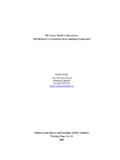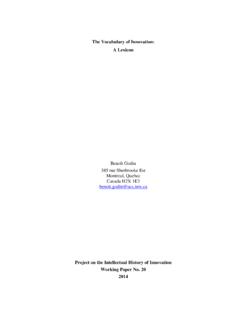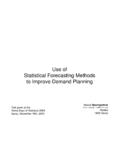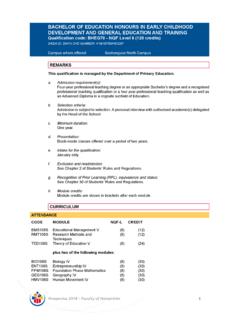Transcription of The Korean system of innovation and the …
1 The Korean system of innovation and the semiconductor industry : a governance perspective (SPRU/SEI-Working Paper: forthcoming). Dr. S. Ran Kim . December 1996. This paper is written as part of the Science Policy Research Unit/Sussex European Institute-joint project innovation Dynamics of Pacific Asia: Implications for Europe''. I am very much indebted to comments and suggestions from Christopher Freeman, Mike Hobday, Alan Cawson, Helen Wallace, Wilhelm Schenk, B. A. Lundvall and especially Nick von Tunzelmann. Research Fellow University of Sussex Brighton, BN1 9RF, England Tel: 01273-606755 (Ext.)
2 2452). Fax: 01273-678571. Email: 1996 S. Ran Kim (Science Policy Research Unit/Sussex European Institute). 1. Introduction The semiconductor industry represents one of the most dramatic cases of success that the newly industrialising country, Korea, has achieved. Korean firms like Samsung have been able to catch up and move to the frontier in a narrow range of products of this technology-intensive industry within a very short time, now becoming major global players in the world DRAM market. At the same time, as shown before the quality of the Korean national system of innovation was and is relatively poor, in terms of both its major components and its interactive quality.
3 In dealing with this apparently intriguing phenomenon, we shall here try to explain the growth dynamics of the Korean semiconductor industry . This will be undertaken primarily by using the concept of sectoral governance . We shall reconstruct the historically evolving interactions of state, market and firm, and identify the changing pattern of sectoral governance , its causes, and its consequences for the development process of the Korean semiconductor industry . By examining the ways in which the three critical variables of state, market and firm have interacted and combined to produce the present performance of the Korean semiconductor industry , we shall aim to move beyond the state vs.
4 Market dualism which has dominated the literature on Korean /East Asian industrialisation. In this way, we intend to provide some sophisticated insights into the growth dynamics of the Korean semiconductor industry . Methodologically, we aim at a historically well-grounded analysis of the largely path- dependent development process of the Korean semiconductor industry . We shall therefore inquire into the specific conditions in which state actions, market dynamics and firm strategies have combined to advance the growth and development of the semiconductor industry in Korea.
5 The starting conditions, the specific dynamics, as well as the final outcomes of the development process of the Korean semiconductor industry will be sketched. We consider this kind of mapping-out exercise of the interplay of state, market and firm as essential for a proper understanding of the Korean semiconductor development process. This is also necessary to avoid any ill-judged emulation efforts by other countries of the Korean success in semiconductors . In this paper, we shall argue that the current success of the Korean semiconductor industry is the product neither of the Korea, Inc.
6 '' approach nor of the dynamics of the free'' world market. We shall show that the Korean success in semiconductors involved much more complex and unorthodox interactions between state actions and market dynamics than the proponents of the state or market regulation views on Korean 1. industrialisation normally suggest. Our evidence shows that the Korean semiconductor success is rather the result of the complex interactions between regulations underpinning 1. See for the market regulation view, Balassa (1981) and various world bank publications on the Korean industrialisation.
7 See for the state regulation view, Wade/White (1984) and Deyo (1987). 2. the world market (in particular, the US-Japan semiconductor trade agreements), the largely corporatist state in Korea, and the Chaebols (with their particular structural strengths for effectively mobilising and co-ordinating the necessary actors and resources at the group level). It follows from our revised views that the Korean firms have then become particularly successful in the Dynamic Random Access Memory (DRAM) segment, largely because of the Chaebol- governance which has evolved out of the historical interactions of state, market and firms in the 1980s.
8 In particular, Korea's national political-institutional arrangements, such as the state-firm relationship based upon reciprocal subsidy, have been most conducive to the emergence of this effective Chaebol- governance , which matches very well with the specific technological-economic competitive conditions of the DRAM segment. However, the paper argues thatthe main challenge still lies ahead. It remains doubtful whether the conventional national-institutional structure (with its rather impoverished domestic regime of governance ) will perform well in different product segments into which Korean firms want to diversify, or even in the face of the changed competitive requirements within the DRAM segment itself.
9 This paper is structured as follows. Section 2 provides some information on the actual scale and profile of the Korean success in semiconductors , which is almost entirely based upon DRAMs and is thus highly unbalanced. It also discusses the problems of this kind of one-sided DRAM-based success. Section 3 presents the conceptual and analytical framework to be employed for the study of the growth dynamics of the Korean semiconductor industry (and for the explanation of the Korean DRAM success despite the general weakness of the national system of innovation ). Section 4 is the empirical core of the paper, and contains a detailed analysis of the historical evolution of the sectoral governance structure and development process of Korean semiconductor industry .
10 Section 5 sums up the empirical findings and provides some tentative arguments as to the future development of Korean semiconductor industry . It also identifies the individual role played by the state, firm, and market in the Korean semiconductor development process. Section 6 draws broader conclusions for theory and for possible generalisations of the Korean semiconductor model. To conclude, we shall argue that the concept of the national system of innovation , albeit useful for systematically analysing the national context of firms' competitiveness, should be sharpened towards taking more explicit account of the distinctive socio-political processes which underlie each national system of innovation .

















